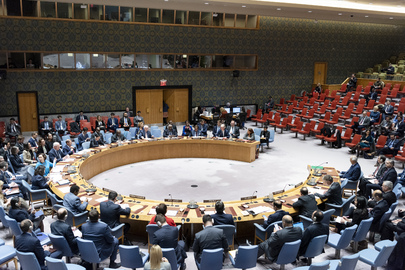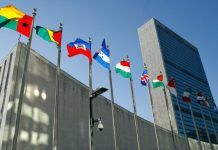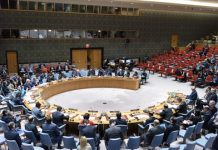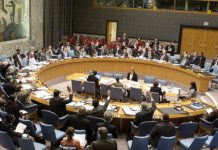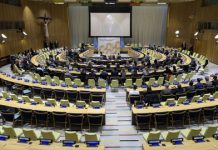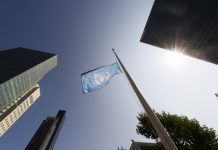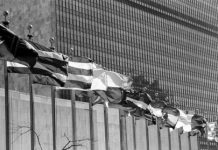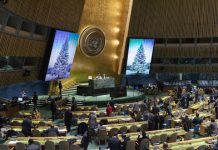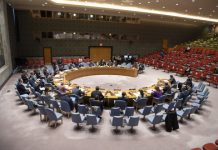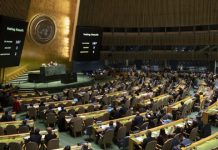Miguel Ángel López, the director of a funeral home in Tibú, used to recover bodies that appeared along the roads of one of Colombia’s most violent regions, Catatumbo. On 15 January, he was murdered along with his wife and their 10-month-old baby while driving a hearse toward Cúcuta, according to local media reports. Only their 10-year-old son survived.
Less than 24 hours later, several former combatants who had signed the 2016 Peace Agreement between the Colombian Government and the FARC-EP armed group were killed.
Since then, thousands have fled as a conflict between the National Liberation Army (ELN) and the FARC group 33rd Front has claimed the lives of at least 80 people and displaced entire communities.
Targeted killings
Diego Andrés García, who works for the UN refugee agency, UNHCR, and coordinates the response of UN agencies and other organizations, said more than 53,000 people have moved to urban centres such as Cúcuta, Ocaña and Tibú
“Human rights leaders had to leave the area due to threats from the armed groups,” he explained “During their departure, there were massacres, targeted killings of leaders and family members being murdered.”
Videos circulating on social media captured the horror of the violence: gunfights, neighbours fleeing on foot, by motorcycle or in boats and teachers from remote areas abandoning their posts, leaving 46,000 children without access to education.
“I lost everything,” said María*, one of the displaced people assisted by UNHCR. “I had to leave with nothing. There was no time.”
Thousands of people have been forced to flee the violence in Catatumbo, seeking safety in Cúcuta.
House of thunder under fire
Catatumbo, which means house of thunder in the Barí Indigenous Peoples language, is a remote and impoverished region rich in biodiversity and natural resources, crisscrossed by rivers and streams in the country’s northeast along the Venezuelan border.
It is also contested territory due to its importance in mining, coca production and illicit trafficking coupled with the State’s weak presence. In recent months, the region has shifted from a tense co-existence between armed groups to an open war for control of the drug trade.
Responding to the crisis, President Gustavo Petro declared a state of emergency in Catatumbo and deployed rapid reaction military units to Ocaña, Norte de Santander. On 17 January, the Colombian president also decided to break peace negotiations with the ELN.
Emergency aid response
UN agencies are now assisting displaced people by providing water, food, hygiene kits, blankets and mattresses to serve more than 46,000 displaced people who sought safety in Cúcuta, Ocaña and Tibú.
In the initial phase of the emergency, agencies responded with local funds allocated for Norte de Santander, however, with more than 80,000 people affected, “the situation surpasses the capacities of local partners, institutions and even the national government,” UNHCR’s Mr. García said.
The UN’s humanitarian coordinator, Tom Fletcher, approved the allocation of $3.8 million from the Central Emergency Response Fund (CERF) to Colombia, allowing for an expanded response to support protection efforts and provisions of shelter, water, sanitation, education, health, food security and nutrition.
Thousands remain trapped
The emergency funds also aim to reach thousands trapped in their homes in the mountain region.
Nearly 8,500 people remain in remote hamlets they cannot leave and where aid cannot reach them, while another 19,000 are facing movement restrictions preventing them from reaching urban centres.
“We are waiting for humanitarian access guarantees so we can deploy responses with our partners,” Mr. García explained.
Aerial image of the Catatumbo region, Colombia.
Cocaine wars
Six decades of conflict in Colombia have claimed 450,000 lives and displaced eight million people, ending eight years ago, when the government and FARC-EP signed a peace agreement that has achieved notable progress.
However, the FARC’s withdrawal from regions like Catatumbo had created a power vacuum quickly filled by other armed groups, including the ELN and dissident factions of the FARC.
This shift reignited territorial disputes in Catatumbo, one of the most complex areas of the conflict due to its remote location along the Venezuelan border. The region is rich in oil and is the country’s largest coca-growing enclave, with multiple armed groups operating within it.
Tibú, a municipality near the Venezuelan border, has the highest number of coca plantations in Colombia, with 23,030 hectares, according to a study by the United Nations Office on Drugs and Crime (UNODC). The Catatumbo region ranks third nationwide, with 43,867 hectares, following the Pacific region (107,078 hectares) and Putumayo-Caquetá (56,933 hectares).
‘Worst humanitarian crisis’
Violence abruptly erupted in mid-January between the ELN and the 33rd Front in the region, forcing thousands to flee the fighting.
“We left in fear,” said Sebastián*. “I left my little land behind. My family and I are now separated.”
Diego Tovar, a former guerrilla and signatory of the peace treaty, told the UN Security Council at an emergency meeting on 22 January that “this is the worst humanitarian crisis we have faced in Colombia since we signed the agreement.”
At the same meeting, Carlos Ruiz Massieu, head of the UN mission responsible for verifying the peace accord, said Catatumbo, like many regions in Colombia, is still waiting for the dividends of the 2016 Peace Agreement, such as a comprehensive State presence that brings public services, legal economies, development opportunities and security.
“It is in the absence of the State that illegal armed groups fight for territorial and social control,” he said.
UNHCR staff at the General Santander Stadium, Cúcuta, where thousands of displaced people from Catatumbo have arrived.
From books to shelter
For now, UN agencies and partners are striving to deliver essential goods and services to those in need, including educational kits and mental health support for thousands of displaced children forced out of school and shelter for those who fled the violence.
“We need to understand that this could be a prolonged emergency,” UNHCR’s Mr. García warned.
Echoing the wishes of many of the displaced people around him, Santiago* said he simply wants to go home.
“All we want is to return,” he said, “but we can’t.”
*Names have been changed to protect identities
Source of original article: United Nations (news.un.org). Photo credit: UN. The content of this article does not necessarily reflect the views or opinion of Global Diaspora News (www.globaldiasporanews.com).
To submit your press release: (https://www.globaldiasporanews.com/pr).
To advertise on Global Diaspora News: (www.globaldiasporanews.com/ads).
Sign up to Global Diaspora News newsletter (https://www.globaldiasporanews.com/newsletter/) to start receiving updates and opportunities directly in your email inbox for free.


